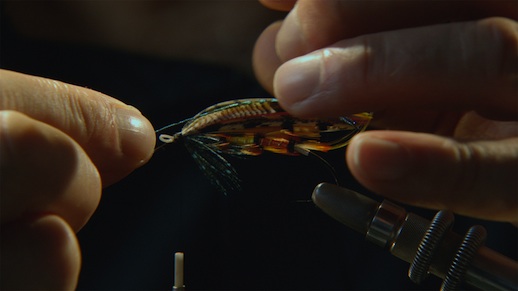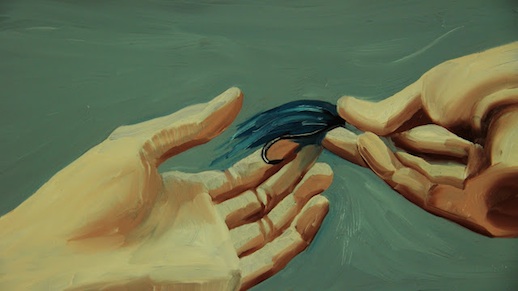Rob St. John reviews Kiss the Water:
Last week, a film documenting the life of Megan Boyd, who through the latter part of the last century tied some of the most elaborate and effective salmon flies ever made from a remote Sutherland cottage, premiered at the Edinburgh Film Festival. The story behind ‘Kiss the Water’ seeded in director Eric Steel’s mind after reading Boyd’s obituary in the New York Times in 2001, a brief remembrance hinting at an extraordinary life of creativity, eccentricity and rural self-sufficiency.
Born in 1915 in England, before moving to the far north of Scotland with her gamekeeper father, Boyd is portrayed as an independent, idiosyncratic and self-sufficient artist. The film ties together a loose collection of remembrances, anecdotes and stories about her life from friends, neighbours and customers, interspersed with oil-paint animations depicting Boyd’s ‘dreamscapes’. Whether she would have approved of such abstract imaginings is debatable. Boyd remains an absent subject of these tellings and retellings of her life, and her physical image is withheld until the closing scenes of the film.
Tales of Megan expand and entwine in warm reminiscence: of her motorbike with Highland cow horn shaped handlebars racing through the glens; the apprentices trekking miles to receive her tuition (tying the tail one month, the body the next…); and the apparent contradictions of her role as an expert fly tier and with an aversion to the act of fishing. Her self-taught expertise, gleaned largely from a single book, was honed in a small, corrugated iron tying shed attached to a cottage overlooking the bay in Kintradwell, Sutherland, where she lived for most of her life. Living purposefully without electricity, a telephone or running water and tying by daylight alone, her flies became revered not only as highly effective lures, but also as precise, beautiful pieces of art.
There’s a poignant beauty in the long, slow shots of her cottage, now abandoned and slowly being reclaimed by nature. A family of foxes nest under the floorboards. Pigeons roost in the rafters, their feathers fluttering slowly through weak daylight in the old tying shed, an echo of the rich creations of fur, floss and feather that previously left this tiny space to be used around the world.
Despite her physical isolation, Boyd’s work (and the salmon fly itself) was a node in a far-reaching global network of trade routes and aristocratic social relations lit by the embers of empire. Orders for her flies came by post from around the world, and many more came from hardy souls – perhaps most notably Prince Charles – who made the trek to her distant cottage to leave their order under the doormat and buy a few of her intricate (and apparently deadly) creations. In this context, the spectre of Boyd’s apparent uneasiness over her relationships with the ruling classes lends a fascinating subtext to the film. On receiving notice that Queen Elizabeth was to award her a British Empire Medal, Boyd sent back a polite note to say should couldn’t attend the ceremony in London as she was playing bridge that night and had no one to look after her dog.
The film itself is perhaps a little flawed, with more than a touch of a Balmoralised romantic gaze on the Highlands and a very odd section dwelling on Princess Diana towards the end. However, it is beautifully shot and the story of Boyd’s life is wonderful, rich and compelling. ‘Kiss the Water’ is well worth seeking out when it receives a wider release.

